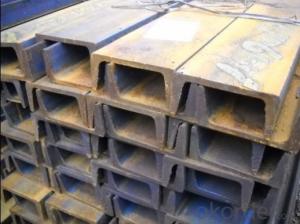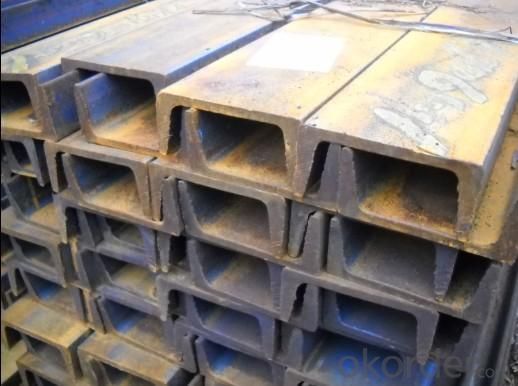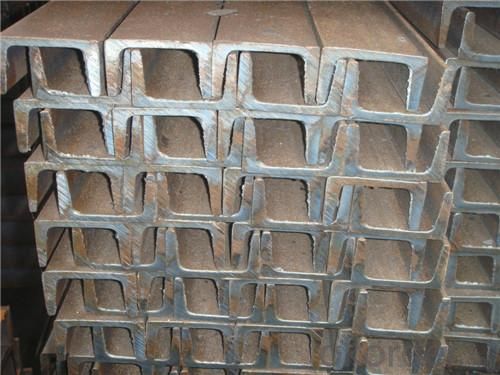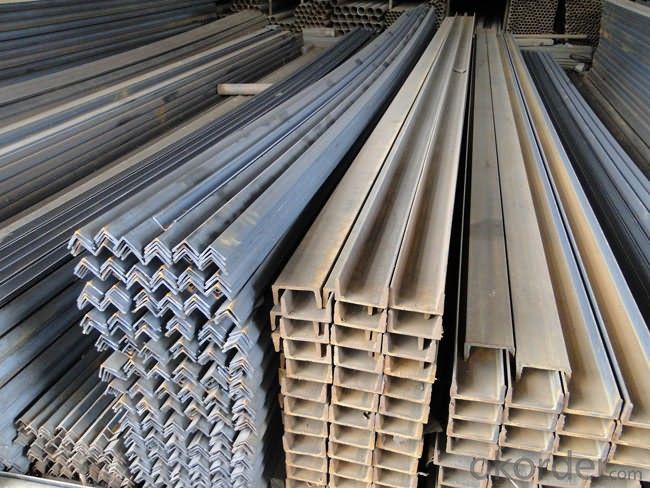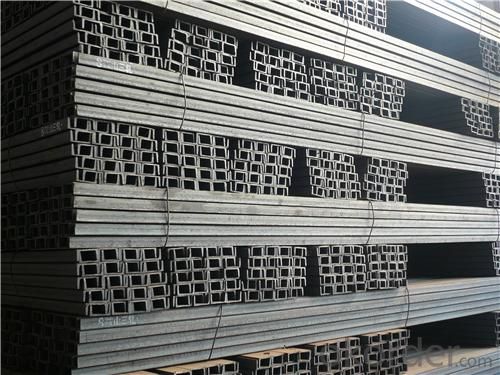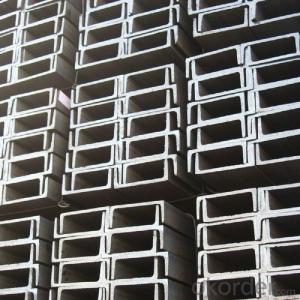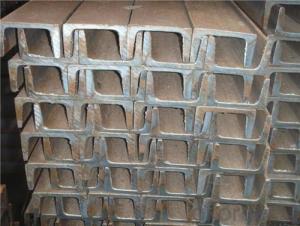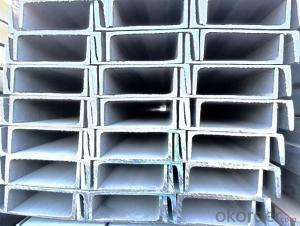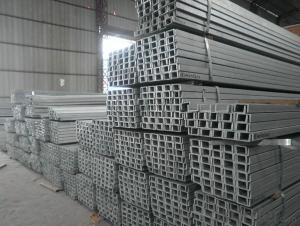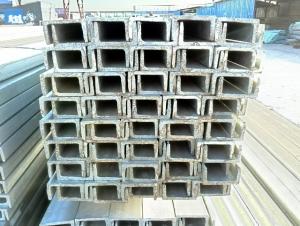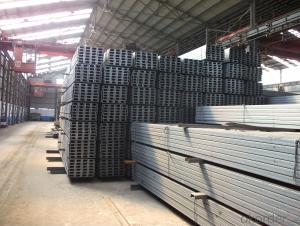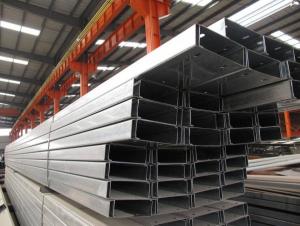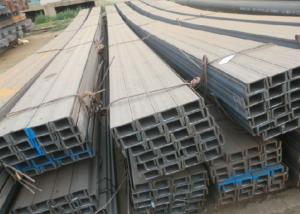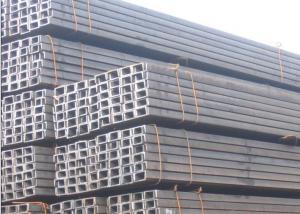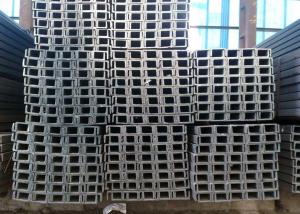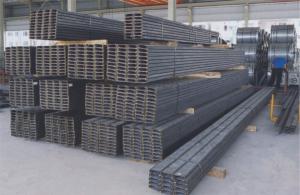80*45*6.0mm JIS U CHANNEL for CONSTRUCTION
- Loading Port:
- Tianjin
- Payment Terms:
- TT OR LC
- Min Order Qty:
- 25 m.t.
- Supply Capability:
- 10000 m.t./month
OKorder Service Pledge
OKorder Financial Service
You Might Also Like
Product Description:
Specifications of JIS Channel:
1. We are definitely speciallizing in manufacturing and supplying channel steel as per japanese standard, which is characterised with high mechanical strength and competitive prices.
2. The sections in details are as followings in the table-1
JIS CHANNEL | Standard h | Sectional b | Dimension s | t | Mass: Kg/m |
| (mm) | (mm) | (mm) | (mm) |
|
50x25 | 50 | 25 | 3.0 | 6.00 | 2.37 |
75X40 | 75 | 40 | 3.8 | 7.00 | 5.30 |
75X40 | 75 | 40 | 4.0 | 7.00 | 5.60 |
75X40 | 75 | 40 | 4.5 | 7.00 | 5.85 |
75X40 | 75 | 40 | 5.0 | 7.00 | 6.92 |
|
|
|
|
|
|
100X50 | 100 | 50 | 3.8 | 6.00 | 7.30 |
100X50 | 100 | 50 | 4.2 | 6.00 | 8.03 |
100X50 | 100 | 50 | 4.5 | 7.50 | 8.97 |
100X50 | 100 | 50 | 5.0 | 7.50 | 9.36 |
|
|
|
|
|
|
125X65 | 125 | 65 | 5.2 | 6.80 | 11.66 |
125X65 | 125 | 65 | 5.3 | 6.80 | 12.17 |
125X65 | 125 | 65 | 5.5 | 8.00 | 12.91 |
125X65 | 125 | 65 | 6.0 | 8.00 | 13.40 |
|
|
|
|
|
|
150x75 | 150 | 75 | 5.5 | 7.30 | 14.66 |
150x75 | 150 | 75 | 5.7 | 10.00 | 16.71 |
150x75 | 150 | 75 | 6.0 | 10.00 | 17.90 |
150x75 | 150 | 75 | 6.5 | 10.00 | 18.60 |
150x75 | 150 | 75 | 6.5 | 10.00 | 24.00 |
|
|
|
|
|
|
200X80 | 200 | 80 | 7.5 | 11.00 | 24.60 |
Table-1
3. The mechanical property of JIS Channel in the table-2:
Grade | Yield Strength,N/mm² | Extension Strength N/mm² | |||
Thickness of Steel,mm | |||||
≦16 | >16-≦40 | >40-≦100 | >100 | ||
SS330 | ≧205 | ≧195 | ≧175 | ≧165 | 330-430 |
SS400 | ≧245 | ≧235 | ≧215 | ≧205 | 400-510 |
SS490 | ≧285 | ≧275 | ≧255 | ≧245 | 490-610 |
SS540 | ≧400 | ≧390 | - | - | ≧540 |
Table-2
4. The chemical composition of JIS Channel in the table-3
Grade | Element(%) | |||
C | Mn | P | S | |
SS330 | -- | -- | ≦0.050 | ≦0.050 |
SS400 | ||||
SS490 | ||||
SS540 | ≦0.30 | ≦1.60 | ≦0.040 | ≦0.040 |
Table-3
Usage of JIS Channel:
1.The JIS channel can be devided into two kinds, namely common channel steel and light channel steel. The sizes of hot rolled common channel steel range from 5# to 40#. Meanwhile, the channel steel can be divided into cold forming sectional equal channel steel, cold forming sectional unequal channel steel, cold forming inner edge channel steel and outer edge channel steel.
2.The JIS channel is usually used for arch-itechtural structure, and they could be welded in order to support or hang a vari-ety of facilities. They are also usually used in combination with I beam. The channel steel with sizes under 14# is usually applied to construction engineering, as purline, while the channel steel with sizes above 16# is more likely to be used in building vehicle chassis structure and mechanical structure. Furthermore, the channel steel in sizes above 30# are target at building bridge structure, as tension bar.
3.In a word, the channel steel must possess perfect welding property, riveting property and mechanical property and so on.
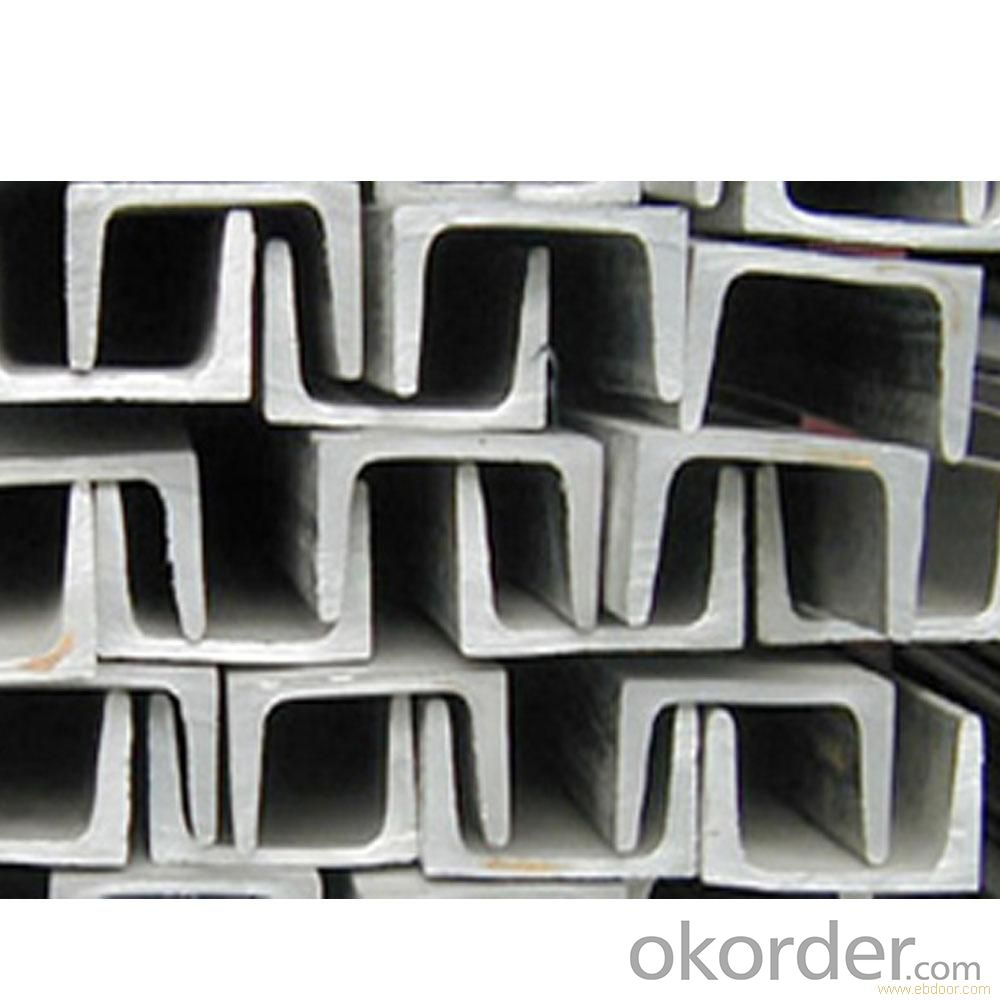
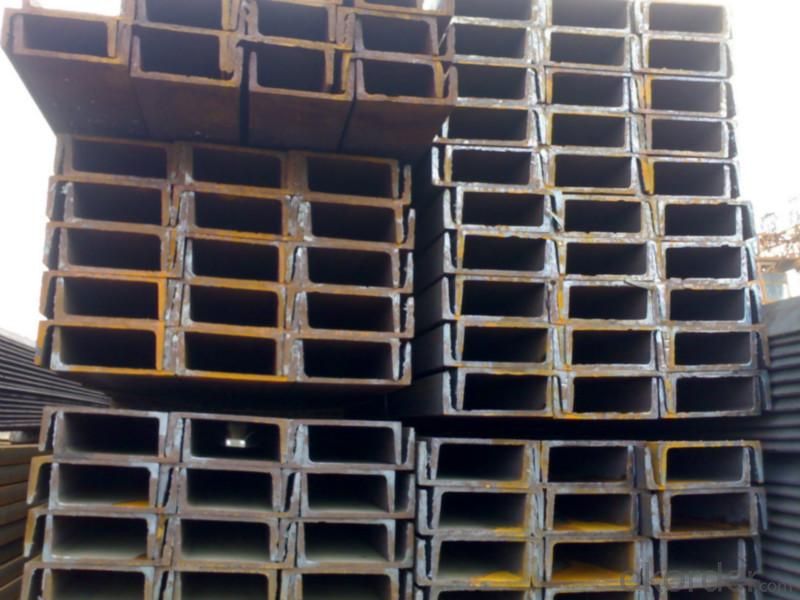

- Q: How do steel channels compare to other structural materials?
- Steel channels are widely regarded as one of the most versatile and reliable structural materials. They offer exceptional strength-to-weight ratio, making them highly efficient in load-bearing applications. Compared to other materials such as wood or concrete, steel channels are more durable, resistant to corrosion, and have superior fire resistance. Additionally, their uniformity and precision in manufacturing ensure consistent quality and ease of installation. Overall, steel channels outperform many other structural materials due to their exceptional strength, durability, and versatility.
- Q: Can steel channels be used in outdoor environments?
- Absolutely! Outdoor environments are perfectly suitable for the utilization of steel channels. Steel, being an incredibly resilient and sturdy substance, can endure a wide range of weather circumstances and environmental elements. Its remarkable capacity to resist rust and corrosion, especially when appropriately coated or galvanized, renders it ideal for outdoor purposes. Steel channels find extensive applications in outdoor construction undertakings, including bridges, fences, railings, and support structures. Nonetheless, it is crucial to guarantee the proper safeguarding and upkeep of the steel channels to avert any possible deterioration or harm over time.
- Q: How do steel channels perform in earthquake-prone areas?
- Steel channels perform well in earthquake-prone areas due to their high strength and ductility. They can effectively absorb and distribute seismic forces, providing enhanced resistance to structural damage. Additionally, steel channels can be designed to flex and bend during an earthquake, minimizing the risk of collapse and ensuring the safety of buildings and structures in these regions.
- Q: You design expert asked: do barrier 5 meters, how long the channel to bear?
- With 10 channel (GB) between 800 to 1000 longitudinal horizontal laying, select the 5# angle, the middle span up to 7M without support (pillar). Compares the aspect to the full use of meters. With No. 10 square tube pitch 610--810 survived, white painted with the suitable iron staircase is beautiful. The ceiling also save cost, also there are no pillars stairs is a good point. I think I've seen a picture in the post, is to use local square steel tubes do, sensory or good.
- Q: How do steel channels contribute to acoustic performance?
- Steel channels can play a significant role in improving acoustic performance in various applications. One of the key contributions of steel channels to acoustic performance is their ability to minimize sound transmission and improve sound insulation. Steel channels are often used as part of wall or ceiling systems in buildings to create a barrier that prevents sound from traveling between different spaces. The design and construction of steel channels allow for the installation of sound insulation materials such as mineral wool or acoustic foam. These materials help to absorb and dampen sound waves, reducing the transmission of noise from one area to another. By incorporating steel channels in the construction of walls or ceilings, the overall acoustic performance of a space can be greatly enhanced. In addition to their sound insulation properties, steel channels can also contribute to the improvement of room acoustics. By using steel channels to create a suspended ceiling, for example, it is possible to create a more balanced and controlled sound environment. The space between the steel channels can be filled with acoustic tiles or panels, which can absorb sound reflections and reduce echoes, resulting in better speech intelligibility and overall sound quality. Moreover, steel channels can also be used to support the installation of sound-absorbing materials on walls or ceilings. These materials, such as fabric-wrapped panels or perforated metal sheets, can help to reduce reverberation and echo in a room, improving its acoustic performance. Steel channels provide a sturdy framework to securely mount these materials, ensuring their effectiveness in enhancing sound absorption. Overall, steel channels contribute to acoustic performance by reducing sound transmission, improving sound insulation, and enhancing room acoustics. Whether used in the construction of walls, ceilings, or as a support for sound-absorbing materials, steel channels play a vital role in creating a more acoustically favorable environment, whether it be in residential, commercial, or industrial settings.
- Q: Can steel channels be used for supporting walkways and platforms?
- Indeed, walkways and platforms can be supported by steel channels. In construction endeavors, steel channels are widely employed due to their robustness and endurance. These channels furnish a firm and steadfast support framework, rendering them optimal for walkway and platform support. They can be tailored to meet precise load demands and effortlessly assembled to forge a secure and trustworthy structure. Furthermore, steel channels can undergo galvanization or coating to enhance their resistance against corrosion, thereby guaranteeing their longevity and safety.
- Q: How do steel channels enhance the aesthetics of a building?
- Steel channels can enhance the aesthetics of a building by providing a sleek and modern appearance. The clean lines and sharp edges of steel channels create a visually appealing and contemporary look that can elevate the overall design of a structure. Additionally, steel channels can be used to create interesting geometric patterns or accents, adding depth and visual interest to the building's facade.
- Q: How do steel channels contribute to load distribution?
- Steel channels contribute to load distribution by providing structural support and distributing the weight of the load evenly across the channel's length. These channels help to minimize stress concentrations and ensure that the load is evenly distributed to prevent any localized areas from bearing excessive weight.
- Q: How do steel channels contribute to the overall cost-effectiveness of a project?
- Steel channels contribute to the overall cost-effectiveness of a project in several ways. Firstly, steel channels are known for their durability and strength, which means they have a longer lifespan compared to other materials. This results in reduced maintenance and replacement costs over time, thus saving money in the long run. Additionally, steel channels are lightweight yet robust, making them easier and more cost-effective to transport and handle during construction. This can reduce labor and transportation costs, as well as the need for heavy machinery, ultimately contributing to overall cost savings. Moreover, steel channels are versatile and can be easily fabricated to meet specific project requirements. Their adaptability allows for efficient customization, eliminating wastage and reducing material costs. Furthermore, steel channels have excellent corrosion resistance properties, reducing the need for regular maintenance and extending their lifespan, thus providing additional cost savings. Furthermore, steel channels are often produced using recycled steel, which is not only environmentally friendly but also cost-effective. By utilizing recycled materials, the overall cost of production can be reduced, making steel channels a more affordable choice for construction projects. Lastly, steel channels offer a high strength-to-weight ratio, meaning fewer materials are needed to achieve the same structural integrity compared to other materials. This results in cost savings in terms of material procurement and construction time, as less material needs to be installed. In conclusion, steel channels contribute to the overall cost-effectiveness of a project by providing durability, lightweight characteristics, adaptability, corrosion resistance, and the potential for using recycled materials. By considering these factors, the use of steel channels in construction projects can lead to significant cost savings, making them a cost-effective choice for various applications.
- Q: Can steel channels be used in outdoor applications?
- Yes, steel channels can be used in outdoor applications. Steel channels are made from strong and durable steel material, making them resistant to harsh weather conditions such as rain, snow, and extreme temperatures. They are commonly used in outdoor structures like bridges, highways, and outdoor equipment due to their high strength and ability to withstand heavy loads. Additionally, steel channels can be treated with protective coatings such as galvanization or powder coating to further enhance their resistance to corrosion and rust, making them suitable for long-term outdoor use.
Send your message to us
80*45*6.0mm JIS U CHANNEL for CONSTRUCTION
- Loading Port:
- Tianjin
- Payment Terms:
- TT OR LC
- Min Order Qty:
- 25 m.t.
- Supply Capability:
- 10000 m.t./month
OKorder Service Pledge
OKorder Financial Service
Similar products
Hot products
Hot Searches
Related keywords
